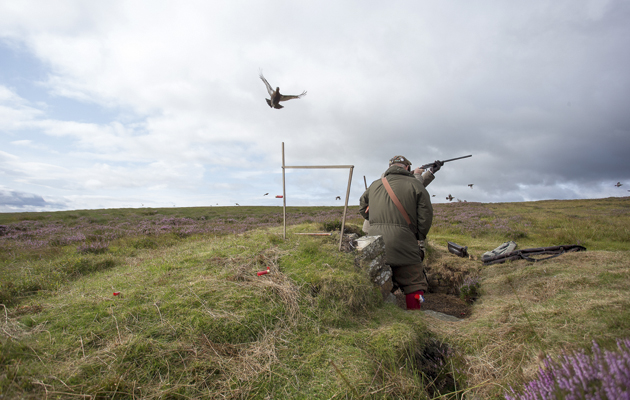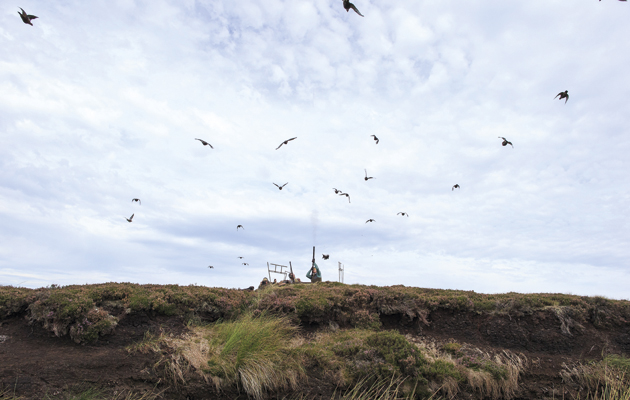The journey from dufferdom to competence can be a tough one. Tarquin Millington-Drake shares his hard-won advice on how to shoot grouse. This advice is not to be missed.
How to shoot grouse well is what those heading to the moor for the first or fourtieth time always keep in mind. No one stands in the butt without some trepidation. Grouse shooting is a privilege and you should perform to the best of your ability.
Be inspired by a day on the moor and see what happened on the Helbeck Estate. Or if you’re keen to shoot your grouse as part of something different try The Field’s Macnab Challenge in association with Glenfarclas Whisky, Hine Cognac and Champagne Pol Roger.
To prepare yourself for the moor follow Millington-Drake’s lead below.
HOW TO SHOOT GROUSE
“Just shoot,” was the seemingly unhelpful advice I was given on returning to shooting grouse after a 20-year break. As it turned out, it was good advice once I came to understand the context in which it was given. But how else does one set about preparing and then performing when the dream grouse invitation does finally arrive? Just what lessons need to be learned about how to shoot grouse? With modern grouse-moor management meaning there are more grouse about, an invitation is perhaps more likely now than it has ever been, or you may get a crack at them by taking a day or two at more affordable prices.
As a photographer of grouse and grouse- shooting, I have watched a huge number of people from the worst to the very best but I am not one of the legendary grouse-shots who bounce around the moors; I have made the journey from what I now realise was awesomely crap to acceptable over several years. For the grouse gurus this knowledge about how to shoot grouse seems to come direct from the sporting gods.
So, when the invitation does come, where to start? What can be done off the moor to prepare? Firstly, accept that how to shoot grouse is unlike shooting anything else other than pigeon coming into decoys. If you can, practise on pigeon, perhaps by buying a few days with a professional pigeon guide during harvest.
HOW TO SHOOT GROUSE: INSTRUCTION
There’s no doubt that time with a specialist grouse instructor in a shooting school’s grouse butt is well spent understanding how to shoot grouse. But only if you insist on the traps being tuned to throw head-high targets rather than the partridge-like ones that many places show because of safety concerns. Although this does not adequately simulate the real thing, if nothing else, it prepares you for the environment and safety aspects of how to shoot driven grouse.
It will also reveal whether or not your gun fits properly. It’s possible to get away with a poorly fitted gun shooting pheasants and partridges but when the gun is parallel with the ground your head must be snug with the stock and your eye properly aligned. Also, a good instructor will show you how to use double guns properly, which is an art form (and you will need double guns on anything other than a small day, to maximise the chances of making a bag as the grouse sweep through).
HOW TO SHOOT GROUSE: CLOTHING AND EQUIPMENT
- In terms of equipment and clothing, wear the same as for a normal day’s shooting but lose the bright shirt and tie and go dark green or brown unless you want to be kind to your neighbours in the line.
- Regulars on the hill tend to wear boots for ankle support.
- A stick is a good idea for your walk across the heather, and a hill bag should contain the all-important safety glasses, ear defenders, midge repellent, some kind of marker to record where fallen birds are, maybe a bottle of water and a dog lead if appropriate.
- Do put your dog on a lead; a dog running around the moor during a grouse drive is a bad idea.
- A range finder is useful – great for getting a feel for your distances, especially out in front of the butt and for distancing flankers.
HOW TO SHOOT GROUSE: SAFETY
Being a safe shot is crucial on the moor. Tarquin Millington-Drake examines how to shoot grouse safely and the three big errors he has seen on the moor.
Shoot grouse safely. The three big errors to avoid.
How to shoot grouse safely is the primary concern of anyone standing in a grouse butt. You must be aware…
HOW TO SHOOT GROUSE: YOUR FIRST BUTT
The time has come; you have arrived at your first butt, a magical sporting moment that carries much anticipation. Try to take a little time to look around you. Look at the ground in front and behind. Do not be shy in asking the advice of your loader, especially if he’s a local man. You will always learn something and there’s a very high chance that he’s been in that exact butt a score of times and will have a good idea of what line the birds will take. Also, two pairs of eyes are invaluable so ask him to alert you to any approaching birds. Will the birds coming towards and going away from you be rising or dropping? These details are useful in the heat of battle. Try to choose mental markers (or actual ones if you have a range finder); pick a rock or piece of heather where you should be lifting your gun to oncoming birds. Talk to your loader about it, as the chances are he knows how the birds will come and therefore what feature makes a good marker.
Having got comfortable with the safety issue, the next challenge is shooting early enough. That is not to say you should be trying to shoot at them 60yd out. The top shots might be capable of that but their real killing zone is 45yd to 20yd out and they will be aiming to shoot two birds in front. Your objective should be to shoot a bird with every two shots. Don’t think about two. If you get the first one with the first shot then, of course, have a go but pick your bird and focus on it. This is where the ‘‘just shoot’’ comment was right.
When the birds arrive at your chosen markers, do not start thinking about shooting or tracking and swinging: lift the gun, do what is natural and just shoot. You do not have time to analyse, just rely on your natural ability. A common problem is that new grouse-shots are unused to shooting at birds without sky so they wait far too long to shoot and the speed of the grouse means they try to catch up far too late, swinging the gun violently as the bird is upon them. This is where markers really help. It is better that approaching birds do not see you, so there is something to be said for keeping low and trying to ensure you are not above the skyline, but usually it is far more effective simply to keep perfectly still until it is time to shoot. If you hide and pop up, particularly later in the season, you will flare the birds.
HOW TO SHOOT GROUSE: AFTER THE FIRST SHOT
You have fired your first two shots, now what? There is much talk about two in front and two behind but the really good shots are good not only because of their accuracy but because of their ability to read what to do next. Too many of us are too quick to chase birds out of the back of the butt (especially if we missed them in front) when some perfectly good birds are following those we have just shot at. We get what is called “turned around” and there is a lot to be said for standing one’s ground and facing forward to avoid this. The problem is: you turn around to shoot, turn back and another grouse is whizzing past you so you turn back to shoot at that and more come and so on. At some point you have to let some go to return to shooting in front. I have numerous photographs of guns shooting out the back while birds pour forward towards them.
Often, new invitees are asked to shoot later in the season but before the really testing shooting starts. The birds may have begun to “pack up” by then into groups of 100 to 300. We struggle to choose a bird when these packs come through the line and, having missed many, we try to save our dignity by turning around to get one out the back. What we should do is remain still and calm. The packs are often cigar shaped so we should fire two shots in front, stay still, calmly take a second gun and take two more shots and then two more, remaining focused on the front. More often than not, if it is a pack, at least four and maybe six shots can be taken on oncoming birds before the need to turn around. If you turn around instantly, when you face the front again there will be a whole lot of birds upon you that you could have been shooting at.
The beaters are now approaching the line of butts and another feature of grouse-shooting emerges to put you off. We low-ground shots have been taught not to shoot at people, and no matter how far away it is disconcerting. On most moors a horn will sound to stop shooting in front and it is best that you signal to your neighbours when you hear this and ensure they have heard it, too. Nobody will criticise you for stopping shooting in front if you have concerns, so discuss it with your loader, maybe narrow the window between your sticks if you continue shooting or stop altogether if you and your loader think it appropriate. Once the horn has sounded, you should turn around but lean on the front of your butt so that you are well within your sticks and cannot address birds too early, endangering your neighbour. Never shoot high grouse over the beaters unless you have been given specific permission to do so by your host. Even then, the beating line may well give you a hard look as they come through the line.
Soon a second horn will signify that the drive is over. Help pick-up your birds and leave them on the front of your butt for collection. If you are missing birds, tell a keeper or picker-up so they can have a good look.
Grouse-shooting is the pinnacle of driven shooting and one wants to make the most of the day and do well. To achieve that you really have to be right on your mettle. For me, the key was to understand how to shoot grouse safely. Then I could relax and focus on the grouse. Don’t forget to look around you and enjoy the spectacle of the moor itself and some of Britain’s unique and most beautiful countryside.










